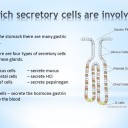Control of digestive secretions
In this activity students are introduced to the control of gastric secretions with a short video. Then they construct a flow diagram of the control of gastric secretions in the digestive system using a set of SOLO hexagons to reveal how the brain uses nerve impulses and hormones to control the production these secretions. This is completed by a set of IB style questions where students are encouraged to think carefully which are the relevant details to include in their answers of each question.
Lesson Description
Guiding Question
- Do your stomach lining, the pancreas and other digestive glands produce digestive juices all the time?
- Do these secretions always contain the same amounts of digestive enzymes?
- If not, how are these glands controlled?
Activity 1 - Introduction to the control of digestive juices?
Watch the two short introductory videos - don't worry about the details (some are beyond IB) - then continue to activity 2.
Activity 2 - What happens when you see / smell food?
This activity looks at the nervous and hormonal systems which control our digestive system.
Review the slides below which explain the essential components in the control of gastric secretions.
Use ![]() the gastric control student worksheet below which contains a summary diagram for students to annotate.
the gastric control student worksheet below which contains a summary diagram for students to annotate.
The second page contians SOLO hexagons outlining the control of gastric secretion. Students cut these out and arrange them into sequences which explain the detials of the processes involved in the control of gastric secretions.
Activity 3 - Three IB style questions
These questions illustrate how once you have learned a topic in IB biology you still need to think carefully when choosing the details to include in the exam questions.
![]() IB style questions about the control of digestive secretions
IB style questions about the control of digestive secretions
Teacher's notes
The first activity is simply a choice of two good videos which introduce the idea clearly.
Activity 2 using the SOLO hexagons is an excellent chance for students to sort their ideas into a clear sequence which explains the concepts and provides some notes at the same time.
Note: SOLO Taxonomy (structure of observed learning outcomes) provides a simple model for three levels of understanding, surface, deep and conceptual (Biggs and Collis 1982). I find it is useful for helping students to develop a connected conceptual understanding of biological processes, and it's a quick visual aid to see how well students are doing in the lesson.
Activity 3 consolidates this learning and encourages students to use precice and relevant details in their answers. Often students write answers which simply regurgitate their revision notes without thinking. This is an opportunity to reinforce this point during the lesson.
You can find Control of gastric secretions IB style - Model answers on this page (teachers can control student access in the group setting on the student access. Use the "add/edit content" button at the top of the page.

 IB Docs (2) Team
IB Docs (2) Team





